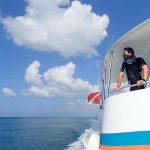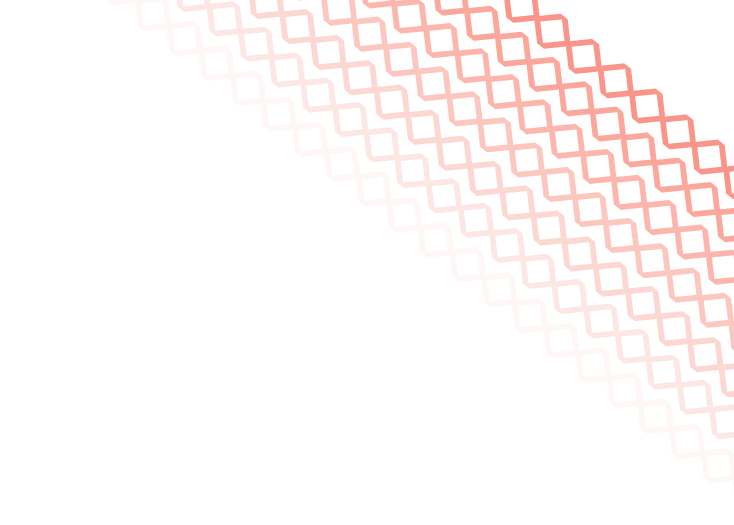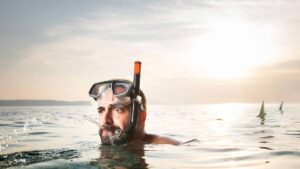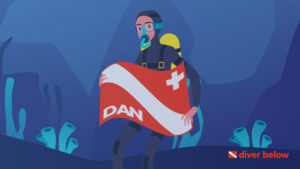The dive regulator is perhaps the vital piece of equipment a scuba diver uses.
It delivers air from your scuba tank to your mouth and into your lungs, so it’s an essential part of scuba diving gear.
Let’s look at what a reg is and how it works.
Since it’s such a necessary thing, it behooves divers to know as much as they can about it.
Contents
What Is a Scuba Regulator?
The regulator is the part you put in your mouth.
Since the air in your scuba tank is pressurized, you need a regulator to access the air in your tank.
That pressurization means the air in the tank averages about 3,000 psi.
That’s quite a lot of pressure, so the regulator works to decrease the pressure between the tank and the breathing of the air you will need to be alive under the water.
How Does a Scuba Regulator Work?
The process of receiving air from the cylinder (or tank) holding all the pressurized air happens in two stages.
The first stage lets air out of the tank and into a chamber, which drops the air pressure to something of an intermediate pressure, usually around 140 psi.
The air moves next into the low-pressure hose, where it reaches the second stage.
The second stage has a diaphragm that responds to changes you make in the air pressure.
When you breathe in through the mouthpiece, the lowered air pressure resulting from you sucking in air triggers the diaphragm.
This essentially cracks its seal enough to let some air leave the low-pressure hose, flow into the mouthpiece, then your mouth, and then your lungs.
The second stage also converts the air pressure, again lowering it to the ambient pressure, meaning the same pressure as the water you’re in.
This is important because as you dive deeper, pressure increases, and if the air pressure were to stay the same as when you were above the water, you could seriously injure your lungs.
What’s It Like to Breathe from a Scuba Regulator?
For most people, breathing from a scuba regulator might be a little weird at first, but it eventually becomes second nature.
For many first-timers, it’s just like breathing normally, although a good instructor will make sure you learn to breathe a bit more slowly and deeply than normal.
However, some people have trouble making themselves breathe while underwater.
Most overcome that by putting water in their mask while above the water or even breathing normally while in the shower.
The idea is to get used to breathing while there’s water on your face.
As you dive deeper, some regulators can require more effort on the diver’s part to breathe.
In that case, you work a little harder, but the mechanism of breathing remains unchanged.
Pieces of Scuba Regulators
Regs have lots of moving parts, and familiarity may give you some “piece” of mind when it comes to trusting your life to a piece of machinery.
1. First Stage
The first stage represents the spot where the high-pressure air leaves the scuba tank.
You cannot breathe air at such high-pressure levels, so the first stage’s high-pressure port lowers that pressure before sending the air along into the hose.
2. Inflator Hose
The inflator hose runs to your Buoyancy Control Device (BCD), which you wear to help control your buoyancy.
Sometimes you float. Sometimes you sink.
The inflator hose allows you to fill your BCD with air from your tank so that you can achieve neutral buoyancy, at which point you neither sink nor float.
3. Second Stage
The second stage of your regulator brings the air from your low-pressure hose, equalizes it to the same pressure as the water around you, and feeds it into your mouthpiece.
The diaphragm connects to a lever which opens a valve that allows air to flow into the mouthpiece.
While a regulator itself sometimes gets called a demand valve, the term “demand valve” technically refers to this diaphragm valve.
When you breathe in (“demand” air), the valve complies and feeds ambient-pressure air to you.
The second stage consists of two air providers.
4. Primary air
The primary air is what you usually breathe while diving.
It comes into the mouthpiece through the process mentioned above.
5. Alternate air
A secondary mouthpiece that delivers alternate acts as a backup should anything go wrong with your primary air.
If your dive is uneventful, you won’t use your alternate air.
6. Mouthpiece
As one of the more basic parts of the regulator, the mouthpiece is usually rubber and molded (for comfort) with an edge to fit between your lips and gums.
It also has a spot to bite down on so you can easily keep it in place.
The second stage delivers air to the mouthpiece when you inhale.
When you exhale, the mouthpiece sends that air out through a cover where it bubbles out into the water.
It also contains a purge button to clear any excess water and an adjustment knob to help you fine-tune the mouthpiece.
Types of Scuba Regulators
With a piece of equipment as necessary and complex as a regulator, many variations exist.
Here are some available options for different diving needs.
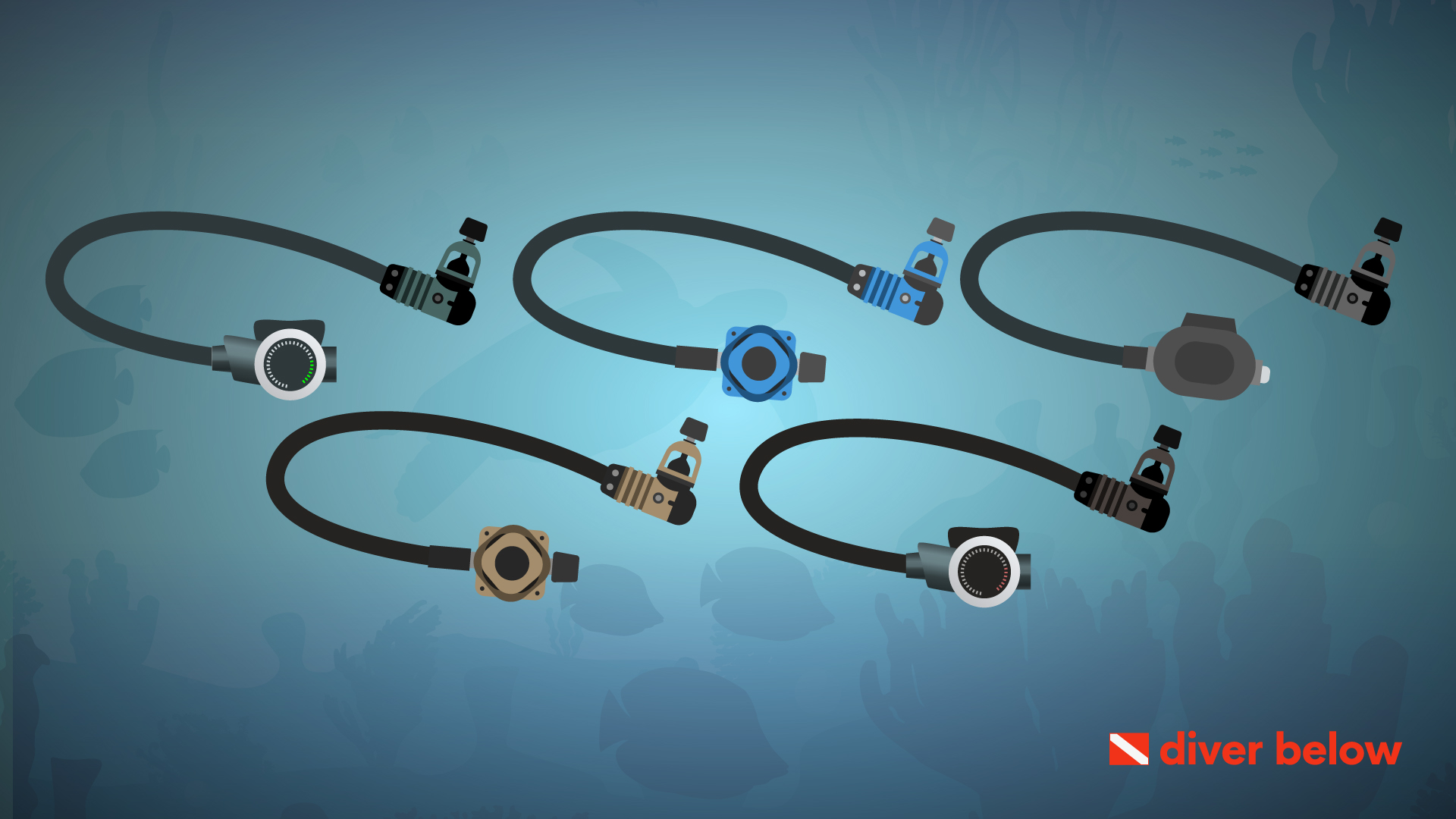
1. Balanced vs. Unbalanced Regulators
While an unbalanced regulator is generally less expensive than a balanced one, both work well, so it isn’t a safety concern.
The basic difference between the two is that a balanced regulator provides for even, balanced performance from your regulator, no matter how much air remains in your diving cylinder or how far down you dive.
An unbalanced regulator becomes a little harder to draw from as pressure drops.
The less air is in your tank, the more difficult it will be to draw breath from it.
Many divers prefer unbalanced regulators for this reason, as the need for more effort acts as a tank gauge: when it starts taking more work to breathe, you automatically know you’re almost out of air and need to think about getting topside.
2. Piston vs. Diaphragm First Stage Regulators
In the first stage, regulators lower air pressure with either pistons or diaphragms.
Both work essentially the same way, and the advantages of one over the other are negligible.
Piston regulators do not have as many moving parts as diaphragm regs, but diaphragms hold a bit of a performance edge.
Both types are fully functional, and for the average sport diver, there isn’t much difference.
3. Yoke vs. DIN Connectors (First Stage)
Yoke or DIN connectors constitute how a reg attaches to the dive tank.
Yoke valves (or connectors) have been more popular among recreational divers.
They connect the first stage to the reg, and the seal forms with an o-ring.
The downside of yokes is that the o-ring is exposed to the elements rather than built into the connector.
DIN is an acronym for Deutsche Industrie Norm.
DIN connectors are gaining in popularity, as they offer a secure seal (the o-ring is built-in), can be used with higher air pressures, and are more compact than yokes.
The biggest draw, though, is that they screw onto the regulator.
There is little chance a DIN connector will ever unhook or otherwise accidentally come loose.
- Read More: Din vs. Yoke regulators
4. Environmentally Sealed Regulators
Divers going into cold water may want to look into an environmentally sealed regulator.
These regs have an extra chamber built onto the first stage, and that chamber holds silicone oil (most often, though other non-freezing liquids get used, as well) to keep the first stage from freezing.
When it does freeze, the first stage can stick open, venting your air rather than letting you breathe it.
At that point, you need to get the first stage thawed out or get to the surface.
All regulators do not come environmentally sealed because this addition makes a reg a bit more expensive.
However, even if you’re not a cold-water diver, environmentally sealed regulators can be beneficial, and they help keep sand and silt out of your first stage.
5. Travel Regulators
Travel regulators are smaller, often weighing less than two pounds.
You’re looking for a relatively low-profile regulator that remains reliable.
In general, the smaller the travel regulator, the more expensive they get.
However, if you want a travel reg, don’t skimp.
That could potentially be a life-threatening decision.
Popular Scuba Regulator Manufacturers
While there are several brands, makes, and models of regs out there, some of the most popular are also among the most reliable.

Dive Rite Regulators
Dive Rite has been making and improving dive equipment since the mid-1980s, and their regulators get high marks all around, as do their regulator accessories.
Atomic Regulators
A two-year, 300-dive warranty grabs your attention with Atomic Regulators.
The company aims to make the best dive equipment in the world, and I can’t deny this because I personally dive with an Atomic T3 on every dive I go on.
They use stainless steel, brass, and titanium, designating them as “environmentally conscious metals.”
Atomic regs come in many configurations, so there’s one for just about anybody.
They’ve also got buckets of regulator accessories.
ScubaPro Regulators
The first company to build a regulator that took advantage of the Venturi effect to make inhalation easier, ScubaPro has been building quality, durable regs for half a century.
Suggested Resource
Best Scuba Regulators: a hand-curated list of the best scuba regulators for divers
Importance of Servicing Scuba Regulators
No matter what the warranty says, get your reg serviced at least once a year.
Even if you didn’t dive more than a day or two this season, when you pull your scuba gear out next season, it will have been sitting for a year.
If you don’t service your regulator and something goes wrong, you could very likely die.
There is no time out if you need to fix something.
Servicing your regulator means taking less of a chance with your life.
Frequently Asked Questions
Covering every single aspect is difficult, but some of the most-asked, regulator-related questions follow.
Can you take a scuba regulator on an airplane?
You can, but you’ll want to check with your airline to see if they have special instructions.
Some specify that scuba equipment can only be checked as baggage, and some allow for various pieces as carry-on.
But generally, yes, you can take your regulator on a plane.
Could a scuba regulator be used as an oxygen mask in a medical setting?
A regulator won’t attach to a medical oxygen tank, and scuba tanks don’t contain pure oxygen, so in many ways, this is an apples-and-oranges kind of question.
That said, the demand valve in medical oxygen-delivery systems and in the second stages of regs is very similar.
Are firefighters’ breathing apparatus similar to a scuba diving regulator?
They are similar but not interchangeable. “Scuba” is an acronym: Self-Contained Underwater Breathing Apparatus.
Firefighters use SCBA units.
Bottom line: you could conceivably breathe in a firefighting situation with a scuba tank and regulator, but you could not successfully dive to any real depth wearing an SCBA.
What happens if you’re in icy water and your regulator freezes up?
Your first stage icing up often means that your second stage will freely spew air from your tank into the water.
You certainly need to get to the surface as quickly as possible because free-flowing scuba tanks get empty surprisingly fast.
Wrapping Up
One of the most important decisions you’ll make regarding your dive gear is your regulator.
Know what you need and what you want in a regulator before you go spending money and before you arbitrarily trust your life to it.
Researching and learning at Diverbelow.com, where you’ll find information and educational resources, might be one of the better decisions you make this week.

